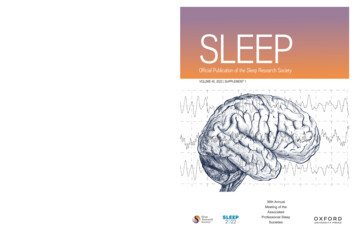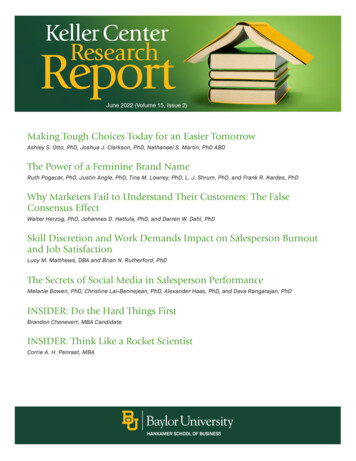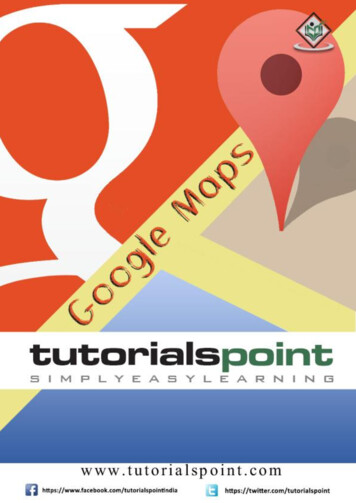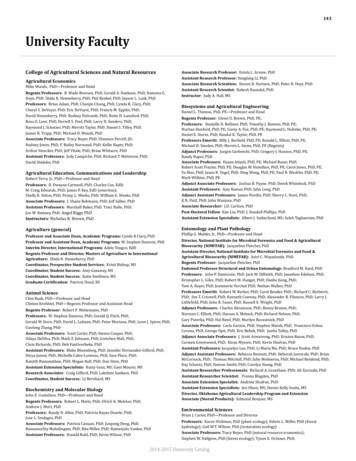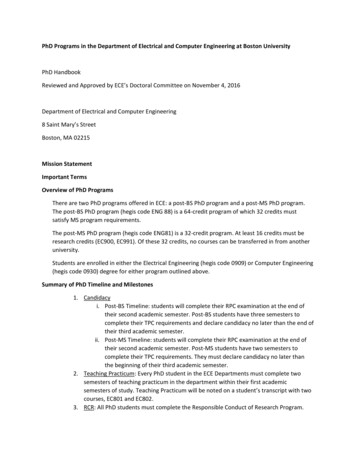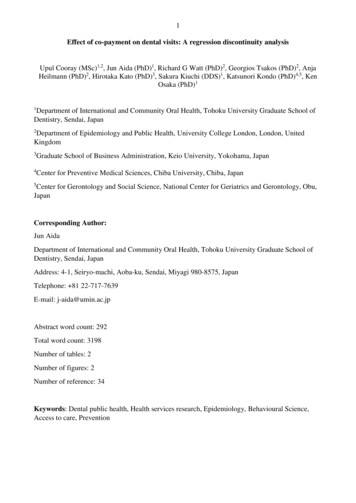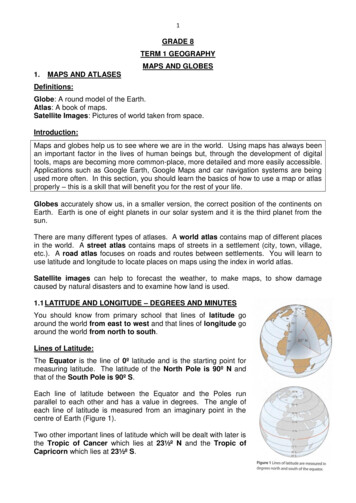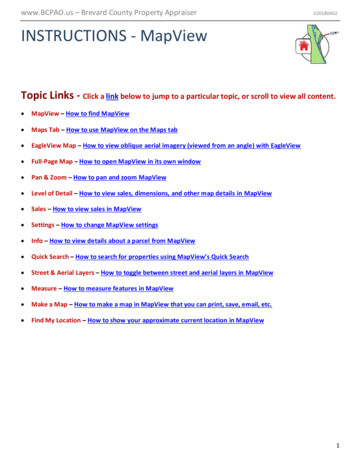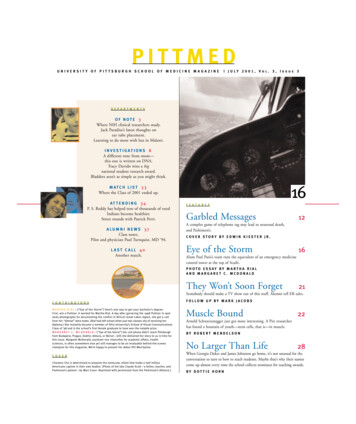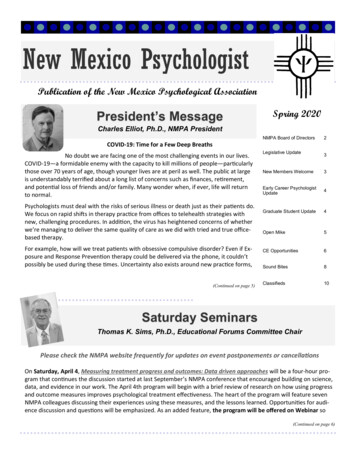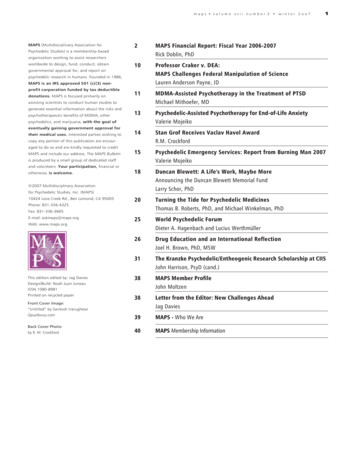
Transcription
maps volume xvii number 3 winter 2oo7MAPS (Multidisciplinary Association for2MAPS Financial Report: Fiscal Year 2006-2007Rick Doblin, PhD10Professor Craker v. DEA:MAPS Challenges Federal Manipulation of ScienceLauren Anderson Payne, JD11MDMA-Assisted Psychotherapy in the Treatment of PTSDMichael Mithoefer, MD13Psychedelic-Assisted Psychotherapy for End-of-Life AnxietyValerie Mojeiko14Stan Grof Receives Vaclav Havel AwardR.M. Crockford15Psychedelic Emergency Services: Report from Burning Man 2007Valerie Mojeiko18Duncan Blewett: A Life's Work, Maybe MoreAnnouncing the Duncan Blewett Memorial FundLarry Schor, PhD20Turning the Tide for Psychedelic MedicinesThomas B. Roberts, PhD, and Michael Winkelman, PhDPsychedelic Studies) is a membership-basedorganization working to assist researchersworldwide to design, fund, conduct, obtaingovernmental approval for, and report onpsychedelic research in humans. Founded in 1986,MAPS is an IRS approved 501 (c)(3) nonprofit corporation funded by tax deductibledonations. MAPS is focused primarily onassisting scientists to conduct human studies togenerate essential information about the risks andpsychotherapeutic benefits of MDMA, otherpsychedelics, and marijuana, with the goal ofeventually gaining government approval fortheir medical uses. Interested parties wishing to1copy any portion of this publication are encouraged to do so and are kindly requested to creditMAPS and include our address. The MAPS Bulletinis produced by a small group of dedicated staffand volunteers. Your participation, financial orotherwise, is welcome. 2007 Multidisciplinary Associationfor Psychedelic Studies, Inc. (MAPS)10424 Love Creek Rd., Ben Lomond, CA 95005Phone: 831-336-4325Fax: 831-336-3665E-mail: askmaps@maps.orgWeb: www.maps.orgThis edition edited by: Jag Davies2526Drug Education and an International ReflectionJoel H. Brown, PhD, MSW31The Kranzke Psychedelic/Entheogenic Research Scholarship at CIISJohn Harrison, PsyD (cand.)38MAPS Member ProfileJohn Moltzen38Letter from the Editor: New Challenges AheadJag Davies39MAPS - Who We Are40MAPS Membership InformationDesign/Build: Noah Juan JuneauISSN 1080-8981Printed on recycled paperFront Cover Image:“Untitled” by Santosh VarugheseOpusNovus.comBack Cover Photo:by R. M. CrockfordWorld Psychedelic ForumDieter A. Hagenbach and Lucius Werthmüller
2maps volume xvii number 3 winter 2oo7MAPS’ Financial Report:Fiscal Year 2006 2007Rick Doblin, PhD, MAPS PresidentFinancial OverviewThe Multidisciplinary Association for Psychedelic Studies (MAPS)turned 21 on April 8, 2007, near the end of Fiscal Year (FY) 2006-07(June 1, 2006 to May 31, 2007). As befitting its emergence into adulthood,MAPS’ FY 06-07 financial performance was better than in any previousyear, with more income ( 1,285,493), more expenses ( 1,288,059) and moreassets at the end of the fiscal year ( 788,694, of which 297,044 wererestricted to various projects and 491,650 were unrestricted). MAPS’ incomefigures are actually 50,000 larger than indicated since these figuresdon’t include an additional 50,000 donated directly to the Swiss MedicalAssociation for Psycholytic Therapy (SAePT) by Swiss citizen Vanja Palmers,for MAPS’ and SAePT’s Swiss MDMA/PTSD study.MAPS also benefits from the donation of a substantial amount of highlyskilled labor from people who assist MAPS with our clinical researchprotocol development and monitoring efforts, website management and design,software development and management consulting services. In addition,MAPS receives much-needed donated labor for a range of office tasks andoutreach efforts, such as tabling at events.MAPS’ income, expenses and assets for the last seven years are presented ina bar chart on page 5. MAPS’ expenses are broken out in detail by project andcategory on page 7. An expanded written description of each project andcategory can be found on the MAPS website at maps.org/fiscalmaps fy2007/projects.pdf. MAPS’ assets, divided into restricted funds for each project and unrestricted funds, are presented on page 8.
maps volume xvii number 3 winter 2oo7Assets: Restricted FundsMAPS permits donors to restrict their contributions tospecific projects. While this limits MAPS’ flexibility toallocate resources to what we consider to be our highestpriorities, this approach enables donors to ensure thattheir resources support their own personal priorities.Furthermore, this approach results in a diversified portfolio of projects. As a result, MAPS will continue to welcomerestricted donations.At the end of FY 06-07, MAPS held 297,044 inrestricted funds. The largest restricted fund, our Start-upFund/UMass Amherst, contains 65,395 contributed byJohn Gilmore. His goal was to catalyze projects in the earlystages when funding is most difficult to obtain, with thegoal being to replenish these funds when the projectscome to fruition. This fund has been used exclusively forour efforts to start a medical marijuana production facilityas a prerequisite to drug development research (see page10), and has been supplemented by grants MAPS hasreceived from the Marijuana Policy Project and the DrugPolicy Alliance.MAPS’ second largest restricted amount is 60,428 forour MDMA psychotherapy effort, from funds donated byPeter Lewis. The rest of the restricted funds can be seen inthe summary chart on page 8.Assets:Unrestricted FundsAt the end of FY 06-07, MAPS held 491,640 inunrestricted assets. Of that amount, 40,000 is the valueof a non-liquid remainder interest in a 1 million home inLa Jolla that was left to MAPS in a bequest. According toactuarial tables, MAPS is likely to receive the full value ofthe home in about 30 years. MAPS’ Board of Directors hasvoted not to sell this asset.MAPS’ liquid unrestricted funds amount to less thanone year’s operating expenses. Looked at in this way, theyprovide a necessary cushion for the fluctuations in MAPS’income due to donors’ preferences and the timing ofcontributions. In addition, these funds enable MAPS tomake commitments to support new pilot projects, so thatresearchers are motivated to invest their precious time indeveloping projects that they know can be funded if andwhen the projects are approved, even if we don’t raisenew funds for the project. To retain this ability to makecommitments, we do seek to raise new funds for allprojects that we have prioritized and that do becomeapproved.In terms of our future fundraising needs, theseunrestricted funds are only about 20% of the cost of onelarge-scale Phase 3 study. MAPS will need to fund twosuch Phase 3 studies for each drug/patient combination toobtain approval for the prescription use of that drug inthose patients. As a result, our unrestricted funds are onlya small down payment on future Phase 3 studies, and onthe completion of our Phase 2 pilot studies should we beunable to raise new funds for those projects.MAPS Fiscal Year 2006-2007IncomeExpensesNet Change1,285,493.051,288,059.26(2,566.21)Net Assets Beginning of Fiscal YearAdjustments For Tax PurposesAdjusted Assets at Beginning of Fiscal YearLess: Net ChangeNet Assets End of Fiscal 34Asset CategoriesAssets: Restricted Funds - LiquidAssets: Unrestricted Funds - LiquidAssets: Remainder Interest in HomeTotal e CategoriesDonations from Individuals & Foundations 1000.00 896,336.00Donations from Individuals 1000.00103,941.00Product Sales: Books, Art, etc127,776.00Other Income: Interest, Conferences157,441.00Total Income1,285,493.00IRS 990 Expense CategoriesResearch ProjectsEducational ProjectsMAPS Bulletin, Website, Forum, & ErowidProject Related Staff/Office ExpensesProduct Costs/Royalties for ArtManagement and GeneralFundraisingCapital ExpendituresTotal ExpensesMAPS canin some waysbe thought of asa mutual fund,seeking diversificationin our 63
4maps volume xvii number 3 winter 2oo7Conceptual OverviewIn last year’s financial report (maps.org/news-letters/v16n3-html/doblin.html), I discussed the three stages ofMAPS’ organizational development. MAPS began operations with a “Low Maintenance/High Performance” stagelasting for its first twenty years. During this time, MAPSstruggled against major cultural and political resistance toinitiate psychedelic and medical marijuana research, withrelatively minimal resources and rare, but crucial, successes. Our educational efforts were often more expensivethan our research efforts.MAPS’ second stage, which we are currentlytransitioning into, consists of a “High Maintenance/HighPerformance” stage. This stage will last for the next 5-10years, when MAPS will need to at least double or tripleits research efforts, income, and expenses, aswe move from sponsoring small pilotstudies to larger Phase 3 confirmatory studies designed to provideevidence of safety and efficacy ofa specific drug for a specificclinical indication.Should our Phase 3studies prove successful,We must be treatingthey will lead to prescription approval. MAPS willa condition that can bethen transition into itsreliably measured, andthird stage, a “No Maintenance/High Performance”that is responsive tostage when MAPS’ furtherresearchand operationalthe therapy we’reexpenses are increasinglydelivering.covered by sales of prescription medicines that we havebeen approved to market (asgenerics); by profits from theoperation of psychedelic clinicsthat MAPS develops, owns andoperates as models in which theseprescription drugs are likely toprescribed, at least initially; and byincome generated by our professionaltraining seminars as we seek to educate psychiatrists,psychologists, nurses, and other mental health professionals about the medical uses of psychedelics and marijuana.Medical Marijuana Research:Fundamentally ObstructedAs long as the federal government holds a monopolyon the supply of marijuana that can be used in FDAapproved research, it doesn’t make financial sense forMAPS to try to conduct medical marijuana research. NIDAdoesn’t have the high THC/high CBD varieties that arerepresentative of the medical-grade marijuana used bymost patients. Moreover, there are unreasonable delays inthe NIDA protocol review process. While FDA is requiredto respond to protocols within 30 days, NIDA has no timelimit and has taken two years to respond to our vaporizerresearch protocol, then rejected the protocol for arbitraryreasons. We immediately filed a response that NIDA hasignored that for two more years - all for a request topurchase 10 grams at cost! NIDA has also refused toprovide marijuana to two MAPS-sponsored protocols thatreceived clearance from FDA.Marijuana drug development research must beconducted with the exact strain that the sponsor plans toask FDA for permission to market. NIDA’s marijuana isgrown for research, not prescription use. If we managed toobtain approval from FDA to market marijuana forprescription use, we would need to negotiate with Professor Mahmoud ElSohly, who grows marijuana undercontract to NIDA, to provide it to us. He’d have a monopoly position and major financial conflict of interestsince DEA has licensed him (but not Prof. Craker) to growfor his own private gain, to extract THC from the plant(less expensive than making it synthetically) for sale toMallinckrodt for use in generic Marinol, against whichsmoked or vaporized marijuana would successfullycompete. Nobody in their right minds would investmillions in research with a drug that they couldn’tguarantee would be available at a reasonable price if thedrug were approved for prescription use.In FY 06-07, MAPS paid 11,800 to UMass-Amherstto support Prof. Craker’s efforts in the lawsuit. Weinvested 23,603 in our effort to generate Congressionalpressure on DEA (see page 10).We also invested 1136 in revising the MAPS/CaNORML vaporizer protocol for resubmission to NIDA,most likely before the end of 2007. We don’t expect thatNIDA will review the protocol in a reasonable amount oftime, or on the basis of the scientific quality of the protocol. But unless we resubmit, we can’t criticize NIDA forignoring or conducting a biased review of a new protocol.Furthermore, there is always the possibility that something will change at NIDA and our protocol will beapproved.Strategy: MDMA for PTSD v. LSD,Psilocybin or MDMA for AnxietyAssociated with End-of-Life IssuesTo make a wise, data-driven decision about whatdrug/patient combination to move first into Phase 3studies, MAPS has a two-pronged strategy. We’re conducting three MDMA/PTSD pilot studies in the US,Switzerland and Israel. This is the drug/patient combination that we currently think is most likely to be able tojustify moving into Phase 3 studies (see maps.org/research/mdmaplan.html for our analysis).In addition, we’re also going to be looking at threedifferent studies using either MDMA, LSD or psilocybin totreat subjects with anxiety associated with end-of-lifeissues (see page 13). These studies seek to meet a need for
5maps volume xvii number 3 winter 2oo71,400,000MAPS 2001 2007 Income, Expenses & Assets1,200,000800,00Assets: 788,694.34Expenses: 1,288,059.26Income: 1,285,493.05Income: 1,156,017.76Assets: 670,152.95Expenses: 903,883.36Income: 812,540.15Assets: 761,496.00Expenses: 653,780.00Income: 1,035,873.00Assets: 379,403.00Expenses: 621,526.00Income: 596,583.00Assets: 404,401.00Expenses: 719,589.00Income: 775,945.00Assets: 349,134.00Expenses: 956,509.00200,000Income: 937,581.00400,000Assets: 783,522.99600,000Expenses: 1,025,475.22TOTAL 5-62006-7FISCAL YEARwhich almost everyone is sympathetic, assisting peoplefacing the reality of death to cope more effectively withfear, anxiety and pain so that they can make the most oftheir remaining time.We made substantial progress in FY 06-07 on startingthe LSD study (investing 17,816) and began work on thepsilocybin study (investing 1,652) and will very likelysee both of these studies approved by early 2008. The LSDstudy will become the first LSD-assisted psychotherapystudy completed in over 35 years. The MDMA study isalready approved but has not yet enrolled any subjects,though that is also about to change as a result of a fewchanges in our inclusion criteria.If these pilot studies demonstrate a favorable risk/benefit ratio for LSD, MDMA and psilocybin, we might beable to design subsequent studies that permit therapists tocustomize a program of psychedelic psychotherapy forindividual patients that utilizes different psychedelics atdifferent stages of the therapeutic process.One serious limitation of these studies is that it mayprove to be quite difficult to capture in standardizedoutcome measures for anxiety and depression the existential changes that subjects may experience as they makeprogress in their psychedelic psychotherapy. We’re engaged not in pure scientific exploration but in drug development. We need to speak to the FDA and other regulatoryagencies in language that they consider valid. We must betreating a disease that can be reliably measured, and that isresponsive to the therapy we’re delivering.Expenses for MDMAPsychotherapy ResearchAs evidence of MAPS’ maturation and transition to aHigh Maintenance/High Performance stage, in FY 06-07MAPS spent 185,456 on our US MDMA/PTSD pilotstudy alone (see pages 11-12). This investment hasgenerated remarkable data and has brought us to the pointwhere we have a good chance to complete the activetreatment component of the study (but not the one-yearfollow-up) before or shortly after the end of FY 07-08.The Washington Post Sunday Magazine will feature a coverstory about this study on November 25, the Sunday afterThanksgiving. We’re both conducting research andengaging in some high-profile public education.Our Swiss MDMA/PTSD study, on which MAPSspent 30,683 with additional sums of about 25,000spent by SAePT, is gathering momentum and activelytreating subjects. Our Israeli MDMA/PTSD study, onwhich we’ve spent 44,687 in FY 06-07 ( 25,000 ofwhich in advance payment for treating the first foursubjects), has not yet started treating subjects but is closeto doing so. The initial male/female co-therapist team thatwe brought to the US for training didn’t feel sufficientlywell-trained so we’re bringing a second team to the US inearly December, 2007 to observe an MDMA/PTSD sessionconducted by Dr. Michael Mithoefer and Annie Mithoefer,BSN. Several potential subjects for the Israeli study havealready been identified, so the study should begin enrolling subjects shortly after the team returns to Israel.
6maps volume xvii number 3 winter 2oo7The need for an MDMA/PTSD therapist trainingprogram, in which we can legally administer MDMA tothe psychedelic-therapists-in-training so that they canunderstand what MDMA does on a personal, subjective,experiential level, has been apparent to us for quite sometime. MAPS’ newest member of the Board of Directors,Shawn Hailey, helped us to identify this need more thanthree years ago. In FY 06-07, MAPS spent just 305 ondevelopment for our therapist training protocol, butexpenses, and progress, have risen substantially in FY 0708, with our goal to submit the protocol to FDA close tothe end of 2007.In FY 06-07, MAPS also spent 22,697 on a series ofother MDMA-related projects. These expenses included 8205 on our ongoing review of the scientific literature about MDMA and Ecstasy; 6000 toanalyze transcripts of MDMA/PTSDtherapy sessions to code for a rangeof defense mechanisms in astudy of process variables thatmay help us understand howMDMA facilitates theacceptance, catharsis andIn recognitionintegration of difficultof the historicemotional and cognitivecontent; 3980 onbreakthroughs on thevarious protocolhorizon we realized thatrefinements for a studyof MDMA-assistedMAPS needed to grow topsychotherapy inhave the capacity to fund,subjects with anxietyassociatedwith admonitor and manage anvanced-stage cancerincreasing number and(MAPS is not sponsoringthisstudy since Peterscale of researchLewis pledged to donatestudies. 250,000 directly to thecover the costs of the study); 3106 on a study to gatheranecdotal reports about thepotential use of MDMA to treatAsberger’s (high-functioning autism); 500 for the Ecstasy pill-testing programthat we conducted with Erowid and Dancesafe,which is now out of funds; 453.25 on preliminarydesign of a protocol to explorethe use of MDMA in higher-risk populations with controlled hypertension, HIV and Hep-C, conditions thatwe think will probably not significantly increaseMDMA’s risk profile when administered within aclinical context; coincidentally, the same amount, 453.25 on exploring ideas to seek approval in Spain forour MDMA/PTSD study that was shut down for politicalreasons in 2002, a study which we would eventuallylike to start after our three pilot studies in the US,Switzerland and Israel are completed.Ibogaine ResearchIn FY 06-07, MAPS spent 10,615 on ibogaineresearch at clinics in Canada and Mexico.MAPS can in some ways be thought of as a mutualfund, seeking diversification in our research projects.Among the most promising areas of psychedelic researchfrom the 1950s and 1960s was in the treatment ofalcoholism and drug addiction. For scientific, compassionate and political reasons, it makes sense for MAPS to try tofacilitate psychedelic research in the treatment of addiction. We’ve selected ibogaine as the drug we’d like toinvestigate because of the large number of anecdotalreports of its successful use in the treatment of opiateaddiction. Ibogaine is legal in much of the world (thoughnot in the US) and there are numerous ibogaine clinicsoffering treatment for addiction. Furthermore, there arestill no published prospective studies on the efficacy ofibogaine.Given our limited resources, and the fact that a Phase1 dose-response safety study with ibogaine has not yetbeen conducted and would likely cost about 250,000,MAPS is not seeking to develop ibogaine into an FDAapproved prescription medicine. Rather, for a fraction ofthe cost of a clinical study, we’re working to conduct anobservational study into the long-term (one year) outcomes of subjects treated with ibogaine for opiate dependence at two legal ibogaine clinics, one in Canada and onein Mexico. We have IRB approval for the study in Canadaand have recruited several subjects into the study. However, recruitment is slow. We’re working through the IRBprocess for a study at a clinic in Mexico and hope to havethe study ready to start around the beginning of 2008.OperationalExpensesIn FY 06-07, MAPS’ Florida-based staff moved to ournew location in Ben Lomond, California, to be nearer toeducational outreach opportunities, and our base ofmembership support. This increased our rental expensessubstantially but also increased our fundraising andcommunity-building potential.In recognition of the promising pilot data beinggenerated in our US MDMA/PTSD study, and the historicbreakthroughs on the horizon — such as obtainingpermission for what will become the first completed LSDassisted psychotherapy study in over 35 years — werealized that MAPS needed to grow to have the capacity tofund, monitor and manage an increasing number andscale of research studies. MAPS therefore added a parttime marketing staff person and a half-time fundraiser, tohelp with the crucial challenge of raising the funds torealize MAPS’ goals. MAPS’ staff has also become moreexperienced and skilled over the years, so some incremental raises were in order. For example, I now earn 60,000a year.
maps volume xvii number 3 winter 2oo7SUMMARY2006-2007Expenses FY 06-07Research ProjectsMAPS Bulletin/Website/InternetIbogaine Follow-Up (Canada & Mexico) 10,614.55LSA Cluster Headache Study 5,264.25LSD Swiss End of Life Study 17,815.81LSD/Psilocybin Cluster Headache 8,624.59MDMA Analysis (Ecstacy Pill Testing) 500.00MDMA Asberger Study 3,105.61MDMA Cancer/Halpern (Harvard) 3,980.31MDMA/Defense Mechanism 6,000.00MDMA/PTSD Israel 44,687.39MDMA Therapist Training 305.25MDMA Lit Review 8,204.75MDMA Phase 1 Safety Study 453.25MDMA PTSD-South Carolina 185,455.68MDMA PTSD-Spain 453.25MDMA PTSD-Swiss 30,683.04MJ Production Facility/UMass Amherst 11,800.00MJ Vaporizor Study 1,135.94Peyote Native American Neurocognitive Study 604.16Psilocybin/Cancer Anxiety Study 1,652.22BulletinInternetWeb AdministrationWebsite Content 24,311.35 6,031.26 11,999.34 3,541.50Maps Bulletin/Website/Internet 45,883.45Fundraising 13,934.69Research Subtotal 341,340.05Education ProjectsBook-LSD My Problem ChildBook-The Ultimate JourneyBurning Man 2006Burning Man 2007Conference-BoomConference PeruDEA/UMASS Cong. Sign on LetterErowid WebsiteEvent - Final FrontierIbogaine DVDMAPS ForumMAPS Staff RetreatS.A.F.E.R./UC Boulder Colorado StateVideo-Difficult Trip GuidanceWomen’s Alliance forMedical Marijuana (WAMM)Women’s Entheogen Fund 928.45 18,933.80 85,520.87 32.50 7,535.21 10,610.62 23,603.11 139,245.89 5,830.53 1,524.00 2,114.00 82.00 60,670.00 584.96Education Subtotal 392,056.37 3,200.00 31,640.43Staff/Operating/Project-Relatedand Management/GeneralCopiesInformation: Books Subscriptions etc PhonesPostalConference FeesAccounting ServicesStaff TravelSalary & TaxesBenefitsCorporate Fees (Bank, credit card, etc )Equipment RentalOffice Moving ExpensesOffice Rent Love CreekOffice Supplies 3,340.95 626.09 9,421.20 13,911.02 2,222.28 4,625.00 27,341.87 269,546.69 53,054.73 10,812.59 2,594.72 11,888.40 23,121.48 10,098.32Overall SubtotalProject Related Staff/Office SutotalManagement and General Subtotal 442,605.34 110,651.34 331,954.01Product Cost/Royalties for ArtBooks, Tapes and AccessoriesLG Hofmann/Chamberlain PortraitHuxley/Chamberlain PortraitRam Dass/Chamberlain PortraitShulgin/ChamberlainGrey/Hofmann PortraitVenosa/Hofmann Portrait 2,710.05 295.00 295.00 2,835.55 343.52 23,113.50 23,186.03Resale/Royalties Subtotal 52,778.65Computer Equip/SoftwareOffice Equipment 3,360.24 4,980.27Capital Subtotal 8,340.51Adjustments for RefundsGrand Total( 8,879.55) 1,288,059.267
8maps volume xvii number 3 winter 2oo7Balance Sheet Restricted 5/31/2007MAPS NET ASSETSTotal Liquid AssetsRemainder Interest in HomeTotal Portfolio, actual value, not costFixed Assets and Secuirty DepositsTotal AssetsMinus RestrictedUnrestrictedAs of 5/31/2007 730,800 40,000770,80017,894788,694297,044491,650RESTRICTED FUNDMDMA Psychotherapy Research EffortVaporizer studyCluster Headache/ClusterbustersLSA ClusterLSD Psilocybin ResearchLSD Psilocybin Cluster HeadacheKetamine TampaVenosa RoyaltiesStart Up Fund/UMass AmherstMPP/DPA/UMASS AmherstCreativity StudySAFERWomen's Entheogen FundWomen's Visionary CongressPsychedelic Difficult Trip VideoSum of Restricted MoneySum of Unrestricted FundsTotal AssetsAs of ,650 788,694Income as Compared to Operational ExpensesAs a result of these expansions, MAPS spent 442,605 on operational expenses, both project-relatedand general management (as compared to a total of 313,419 in FY 05-06), for an increase of 129,186. Aswe had hoped, our income in FY 06-07 increased as wellover that of FY 05-06, by 129,435. Our total assets at theend of FY 06-07 increased as well, by 5171. However,our unrestricted assets declined in FY 06-07 to 491,650,as compared to 516,901 at the end of FY 05-06, a declineof 25,251. This decline, while significant, still indicatesthat we’re close to raising sufficient additional funds tocover the expanded operational expenses that our largernumber of projects requires.MAPS’DonorsMAPS is able to implement our ambitious agenda onlyto the extent that we receive support from our donors. Asthe information presented on page 3 shows, MAPSreceived 103,941 from donors of less than 1000. Thesedonations provide essential support for MAPS’ operationalexpenses and indicate the importance of MAPS’ membership base. Every donation of any amount helps providesnecessary support for MAPS.MAPS also received 896,336 in donations of over 1000, from both individuals and foundations. Thesedonors included Peter Lewis ( 251,125 for MDMAresearch), John Gilmore ( 150,000 unrestricted and 25,000 for Erowid), anonymous bequest ( 87,500 forErowid), MPP grant ( 60,000 for SAFER), RobertBarnhart ( 50,000 unrestricted, 5,000 Women’sEntheogen Fund), MPP grant ( 45,000 for UMassAmherst medical marijuana production facility), RobertKeeler Foundation ( 25,000 for US MDMA/PTSDresearch), Anonymous ( 25,000 for Women’s EntheogenFund), Bryant McBride ( 25,000 unrestricted), Rene Ruiz( 13,000 unrestricted, 10,000 for Erowid), Drug PolicyAlliance ( 12,500 for UMass Amherst medical marijuanaproduction facility), Kevin Herbert ( 7,500 unrestricted, 3,000 for Erowid), Seth Hollub ( 10,000 for clusterheadache research), Robert Field ( 10,000 for SAFER),Tim Butcher ( 7,500 for psychedelic research), WendyGrace ( 5,000 for Women’s Entheogen Fund), RichardWolfe ( 6,000 unrestricted), Mark Anderson ( 5,000unrestricted), David Bronner ( 5,065 unrestricted),Jack Huang ( 5,000 unrestricted), Ed Fenster ( 5,000for Erowid), Anonymous ( 5000, Erowid). There werealso a number of donors who gave between 5000 and 1000. MAPS also benefited from a 50,000 donation
maps volume xvii number 3 winter 2oo7from Swiss citizen Vanja Palmers for our Swiss MDMA/PTSD study. This donation was made directly to the SwissMedical Association for Psycholytic Therapy and doesn’tshow up directly on MAPS’ books.To all of MAPS’ donors, the MAPS staff is doing itsbest to make you proud of the investment you are makingin MAPS’ mission.Shifting From the Approval Processto ImplementationWithin the next few months, the protocol design andapproval process for our LSD and psilocybin end-of-lifeanxiety studies are likely to reach successful conclusions.The Mexican ibogaine study is likely to be approved bythe IRB, allowing it to begin. The MDMA/PTSD therapisttraining protocol will be submitted to FDA, though I can’toffer a realistic prediction of FDA’s response. The newIsraeli MDMA/PTSD co-therapist team will be trained.Minor changes in the Swiss MDMA/PTSD are likely to beapproved so that we can offer up to 5 therapeutic sessionsand up to 150 mgs to subjects who are partially treatmentresistant. In addition, the protocol changes in Dr.Halpern’s MDMA/cancer-anxiety study have already beencompleted such that subject enrollment is imminent.The completion of the protocol development andapproval process, and the start of these new studies, haveseveral major implications. The first is that a substantialamount of my time that has been spent on the protocoldevelopment and approval process will be freed up forother tasks. MAPS’ strategic plan for pilot studies, as I’veoutlined it in this report, will have been achieved. MAPSdoesn’t intend to start many new studies outside of theones I’ve mentioned. We will shift more of our efforts toimplementation of the studies we’ve obtained permissionto conduct. MAPS Director of Operations and ClinicalResearch Associate, Valerie Mojeiko, will have much to do.More FundraisingThe second implication is that MAPS’ fundraisingneeds will continue to grow, so figuring out where toallocate my time, and that of Troy Dayton, our half-timeDirector of Development, will not be difficult.9Management Consulting ProcessPeter Lewis, one of MAPS’ largest donors, has hiredThe Management Center, run by Jerry Hauser andRebecca Epstein, to provide management consultingservices on a pro-bono basis to non-profit organizationsthat Peter funds. Peter has recognized that the skillsnecessary to start a non-profit are different than the skillsnecessary to manage growth as the non-profit begins toachieve some degree of success. Fortunately for MAPS,Peter approved my request that MAPS be placed on thelist of non-profits that Jerry and Rebecca advise.
2 m a p s v o l u m e x v i i n u m b e r 3 w i n t e r 2 o o 7 MAPS' Financial Report: Fiscal Year 2006 2007 Rick Doblin, PhD, MAPS President Financial Overview The Multidisciplinary Association for Psychedelic Studies (MAPS)
